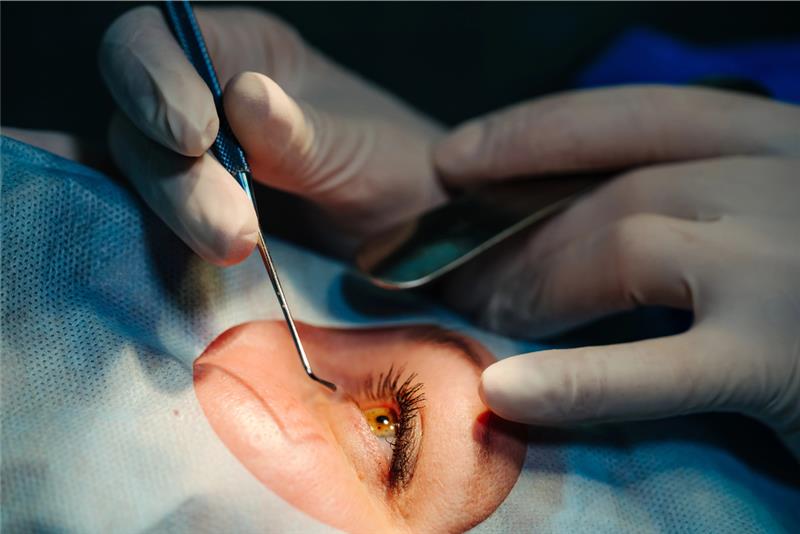Keratoconus is a progressive eye condition that can significantly impact your vision and daily life. If you’ve recently been diagnosed or have been living with keratoconus for some time, you know the importance of consistent management to protect your eyesight. Keep reading to learn long-term care options for keratoconus.
What Is Keratoconus?
Simply put, keratoconus is an eye disorder where the normally round, dome-shaped cornea (the clear front surface of the eye) thins and gradually bulges outward into a cone shape. This change in corneal shape distorts vision, causing blurriness, double vision, streaking, and increased sensitivity to light. People with keratoconus often experience frequent changes in their eyeglass or contact lens prescriptions.
Keratoconus typically begins in the teens or early adulthood and can progress for 10 to 20 years before stabilizing. Due to its progressive nature, regular monitoring by an eye specialist in Glendale is important.
First Steps After Diagnosis
Receiving a keratoconus diagnosis can be overwhelming, but it’s the first step toward effective management. Your Glendale ophthalmologist for keratoconus will conduct comprehensive eye exams, including corneal topography and pachymetry, to map the curvature and measure the thickness of your cornea. This helps determine your current stage of keratoconus, mild, moderate, or advanced, and allows for accurate tracking of its progression.
Based on these findings, your eye care provider will develop a personalized keratoconus treatment in Glendale plan tailored to your specific needs. It’s also important to seek emotional support and educate yourself about the condition so you can make informed decisions about your long-term care needs.
Also Read: What Is Keratoconus? Symptoms, Diagnosis, and Treatment Options
Non-Surgical Management Options
For early-stage keratoconus in Glendale, standard eyeglasses or soft contact lenses might be sufficient to correct vision. However, as the condition progresses and the cornea becomes more irregular, specialized contact lenses are often necessary to achieve optimal vision:
- Rigid Gas Permeable (RGP) Lenses: These hard lenses maintain their shape on the eye, providing a smooth refracting surface to correct vision distortion caused by the irregular cornea.
- Hybrid Lenses: These lenses have a rigid gas permeable center surrounded by a soft skirt, offering the crisp vision of an RGP lens with the comfort of a soft lens.
- Scleral Lenses: Increasingly popular for moderate-to-advanced cases, scleral lenses are large-diameter RGP lenses that vault over the entire cornea and rest on the white part of the eye (sclera). They create a fluid-filled reservoir between the lens and the cornea, which provides a consistently smooth optical surface, significantly increasing comfort and vision stability.
Regular lens fittings and follow-ups with your corneal specialist in Glendale are essential to ensure the best fit, comfort, and vision correction.
Corneal Cross-Linking (CXL)
One of the most significant advancements in keratoconus treatment in Glendale is corneal cross-linking (CXL). This minimally invasive procedure uses a combination of riboflavin eye drops and ultraviolet (UV) light to strengthen the collagen fibers within the cornea, halting the progression of the bulging.
CXL is typically recommended for younger patients or those showing signs of disease progression. It is an FDA-approved treatment that has become a cornerstone of long-term Glendale eye care for keratoconus. While CXL can effectively stop the progression of keratoconus, it is not a “cure” and doesn’t reverse existing vision loss. It can, however, be combined with other vision correction options for keratoconus.
Surgical and Advanced Treatment Options
When non-surgical options are no longer sufficient, or in cases of severe progression, your eye specialist in Glendale may discuss surgical interventions:
- Intacs (Corneal Implants): These small, arc-shaped plastic inserts are surgically placed within the cornea to help flatten its shape, thereby reducing distortion and improving vision. They are reversible and can be removed if needed.
- Topography-Guided PRK: In very select cases where the cornea has a specific pattern of irregularity, topography-guided photorefractive keratectomy (PRK) may be considered to reshape the corneal surface and improve vision. This is less common for keratoconus due to the underlying progressive nature of the condition.
- Corneal Transplant (Keratoplasty): For individuals with severe keratoconus where the cornea has become excessively thin, scarred, or significantly distorted, and other treatments have failed, a corneal transplant may be the only option. This involves replacing the damaged cornea with healthy donor corneal tissue. Recovery and outcomes vary, and a transplant is generally reserved for advanced or aggressively progressing cases.
Daily Living With Keratoconus
Living with keratoconus involves adapting to certain challenges. Managing light sensitivity often means wearing sunglasses, even indoors, or using tinted lenses. Limiting screen time and adjusting screen brightness can help with digital eye strain. Night vision can be particularly challenging due to halos and glare, making night driving difficult for some.
It’s important to avoid eye rubbing, as this can worsen the thinning and bulging of the cornea. Maintaining good eye hygiene and following your corneal specialist in Glendale’s instructions are vital for corneal health. Beyond the physical aspects, developing mental health and coping strategies can help you live well despite visual limitations. Many resources, including support groups, can connect you with others who understand your experience.
Also Read: Keratoconus & Vision Loss: An Ophthalmologist’s Guide to Prevention
Monitoring and Long-Term Follow-Up
Effective management of keratoconus vision loss relies heavily on consistent and proactive monitoring. This isn’t a condition where you can simply get a prescription and be done; it demands an ongoing partnership with your eye care team. Regular corneal imaging, such as corneal topography and tomography (e.g., Pentacam), and comprehensive vision assessments are absolutely essential.
These advanced diagnostic tools provide detailed maps of your corneal shape and thickness, allowing your Glendale ophthalmologist for keratoconus to precisely track even subtle changes in your condition over time. Without this precise data, it’s impossible to know if the keratoconus is stable, progressing, or responding to treatment.
Based on these findings, your specialist can adjust your keratoconus treatment in Glendale plan as needed. This might involve refining your contact lens prescription, recommending a switch to a different type of specialized lens (like scleral lenses), considering corneal cross-linking if progression is noted, or evaluating the suitability of other interventions. The goal is always to provide the best keratoconus treatment in Glendale for your individual circumstances at any given point in your journey with the condition.
Beyond regular check-ups, staying informed about new technologies and ongoing clinical trials is highly beneficial. The field of keratoconus management is constantly evolving, with researchers developing new diagnostic tools, treatment modalities, and even potential therapies that could one day offer more comprehensive solutions. Your corneal specialist in Glendale should be your primary resource for understanding these advancements and determining if any are appropriate for you.
Partnering with a specialized Glendale eye care provider who has extensive experience in keratoconus for ongoing, lifelong care is paramount. They understand the nuances of the condition, the latest treatment protocols, and how to anticipate and address potential challenges, ensuring you receive consistent, high-quality care designed to preserve your vision for the long term. This proactive approach is key to successfully navigating life with keratoconus.
Conclusion
While keratoconus is a lifelong condition, it can be managed effectively with the right support and care. Early intervention, consistent monitoring, and access to evolving treatments are key to preserving your vision. Many patients with keratoconus maintain an excellent quality of life through proper management and the dedication of their eye care team.
If you are seeking expert care for keratoconus or wish to learn more about your long-term management options, contact Soroudi Advanced LASIK & Eye Centers.



